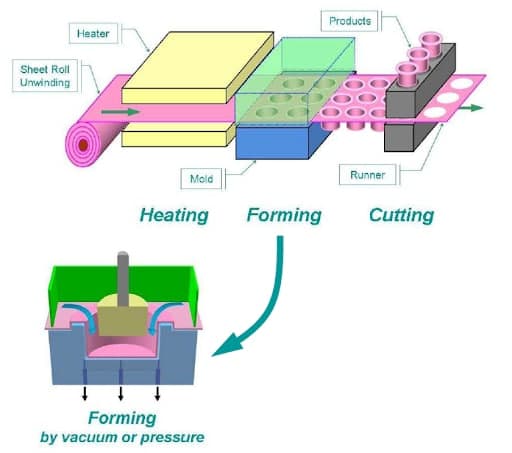We consume staple foods like butter, yogurt, jam, and ketchup every day, but do you ever wonder how those food packages are made? There are some packaging solution designs that are very logical, while others are complicated. Some foods simply require more complex designs because of their texture, shape, consistency and so on. Whether you’re in need of packaging for your dairy products, meat products, seafood, poultry products, dried fruits and vegetables, or medical products, thermoforming is your solution.
What is Thermoforming?
Thermoforming is a technique used to create custom packing solutions. Thermoforming is the process of forming a thermoplastic sheet into a three-dimensional shape. This shape is heated to be soft and formable, then applied to a different vacuum, and pressure, to conform to the shape of a mold. Thermoforming was initially used as a limited application and manual operation for specific materials. These materials would have to be packaged with a longer cycle time through one single cavity. Due to the technological advances over the years, thermoforming has improved to be one of the best technologies in terms of efficiency. Today's rapid research and development allows consumers to work with major resin suppliers, rigid sheet extruders, and original equipment manufacturers in developing high-tech, multi-layered plastic systems, to equal or outperform, traditional manufacturing materials in various applications. Today, thermoforming processes are employed for engineering applications that would've been deemed impossible in earlier decades. Continually improving thermoplastics with modern machinery increased output rates along with the quality, and precision of the moldings.
Thermoforming has conquered an important market share with the pressure forming method of packaging in various food industries. Industries that benefit from and utilize thermoform packaging solutions for their products include food, technology, pharmaceutical companies, among many others.
Thermoform Mold Design
In thermoforming, plastic sheet rolls are thermally heated to be soft and formable. After they're soft enough, pressure and/or a vacuum is applied to form the molding.
The formed products are cut and separated from the skeleton, while the molded products are collected and packed accordingly.
The skeleton is crushed and converted back into pellet form, then mixed with virgin materials, normally at 20 to 30%. Afterwards, it's reprocessed into sheets that makes the thermoforming process a circular economy.
Here are the 6 Main Processes of a Thermoforming Machine:
- Unwinding or Unreeling of Sheet Roll: The sheet is unrolled to dispense the material into the feed zone. Using a guided chain, the sheet is conveyed and is passed through the heater.
- Heating: The sheet is heated to make it soft as a set of parameters.
- Forming (Shaping & Cooling): The soft sheet is formed to the shape of the mold and then allowed to cool.
- Cutting: The molded product is separated from the skeleton.
- Stacking: The product is collected in a stack and then ejected to the conveyor for packing.
- Winding of skeleton: The skeleton is collected and removed for recycling.
The thermoforming process is different from other plastic fabrication processes. The raw materials in thermoforming are not the usual pellets melted to produce desired shapes by die or molds. Instead, the raw materials that are used in the finished product come from the rolled sheet extrusion.

